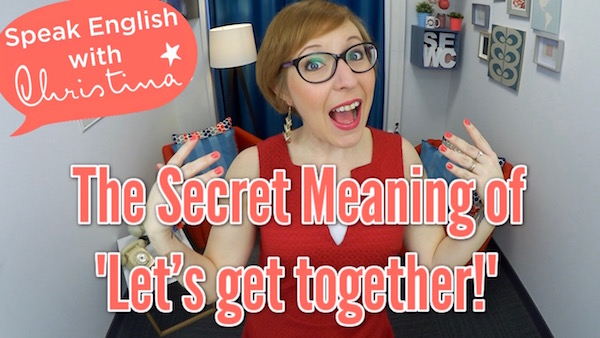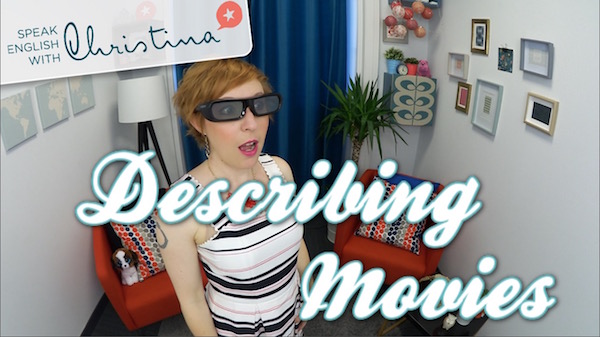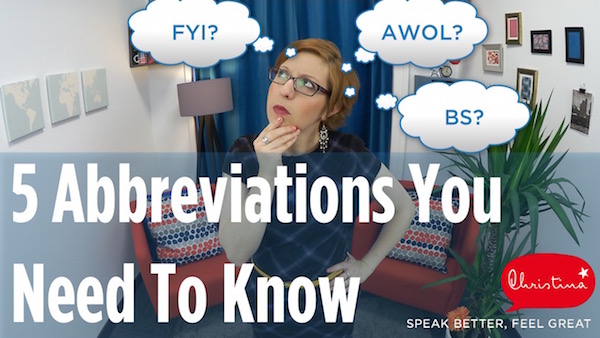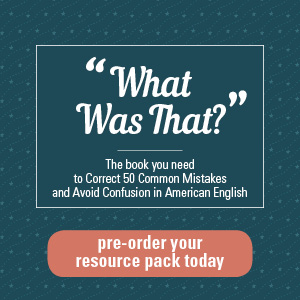
Hey there, and welcome to Speak English with Christina, where you’ll have fun becoming fluent in American English. I’m your English coach Christina, and let me ask you a question.
Has this ever happened to you? You’re in a conversation, and suddenly, you don’t have a specific word you need. You hesitate. You search for the perfect word. The conversation stops and there’s that terrible awkward silence while you’re looking for your words. Ugh. Frustrating.
Today, you’ll learn how to avoid this situation, and continue the conversation fluently, even when you don’t have the exact right word.
Let’s go!
Before we start, let me share with you the site italki, where you can increase your speaking fluency and get lots of conversation practice. Plus, you’ll get $10 in italki credit when you buy your first lesson, because I have a special partnership with them. Click here for more information.
Now, what if you don’t have the exact word you need?
Here are 3 ways to continue the conversation fluidly.
Use “silly” words
I call them silly words, because they sound funny! But they’re actually very common expressions that we native speakers use. In fact, if you use them people might be so impressed that they don’t notice you didn’t have the precise word you’re missing!
These are words like “thingamajig” another one “whatchamacalit”. Or perhaps the most common “thingy”. We use these words in the place of the precise word we don’t have.
For example this little part of a puzzle piece. Do you know what it’s called? I don’t! So I might say “The little thingy on the puzzle piece is missing.” Or “The little thingamajig on the puzzle piece is missing.”
Maybe I want Romain to give me this (watch the video and you’ll see what I’m talking about!) so I can take my Thanksgiving turkey out of the oven. If for some reason I forget the precise word, I would say “Romain, hand me the…the whatchamacalit so I can take the turkey out of the oven.”
Notice that I gave a little description of what I want to do, so that the other person can guess what I’m talking about! If I just say “Hand me the whatchamalit” or “Hand me the thingy”… It’s hard for the other person to know what you’re talking about.
Use general words
“Christina, what’s the English translation for “oto-rhino-laryngologiste?” Sometimes, I get questions like this, where students ask for very, very precise words. They feel like they need to have this very specific vocabulary to sound intelligent or correct.
But even we native speakers often use simpler, more general words. For example, there is an exact translation of “oto-rhino-laryngologiste”. It’s oto-rhino-laryngologist. Good luck with that pronunciation! Even for us Americans it’s hard! So we use the more general “ear, nose, and throat doctor.” Simpler, easier, just as effective!
Another example? Let’s talk about food. Mmm. Maybe you have one word in English to designate the ensemble of fork, knives, and spoons. In English, we do too! Cutlery, or silverware. But if you don’t have this specific word, you can use the more general “forks, knives, and spoons.”
Maybe you don’t know the exact word for this (watch the video to see what “this” is) or this (watch the video) you probably know the general word “boat.” Is it less precise? Yes. But does it allow you to continue the conversation fluidly? Yes. So it’s better than silence!
Describe the thing
Let’s take those last examples. You want to tell your American friend about your last weekend, where you went to the beach and you went on a boat. In your head, you’re thinking of this type of boat. You’ll see an image in the video. But you don’t have the precise word for it. So you can describe it!
For example, “I went on a small boat that uses wind to move forward.” And then your friend will probably confirm your description by saying “You mean ‘a sailboat’?” And bam! You’ve learned a new word! A sailboat!
Another example, let’s say you’ve lost your …. You’re frantically looking for it, and your American colleague asks “What are you looking for?”
You don’t have the precise word for…but you can describe it “I lost my little bag I put pencils in” . And they’ll answer “You mean your pencil case?” And again, new word for you!
When we describe things, we often use relative clauses, like
“a person who…” “a person who…”,
“a thing that…” “a thing that…”,
“a place where….” “a place where….”.
You don’t know the exact word for this job: Describe it as “a person who sells fruit & vegetables at the market.” You don’t know the exact word for this object: say “the thing that opens wine bottles”. And if you don’t have the word for this place: say “the place where you have a lot of stores and you go shopping.”
You can use the vocabulary you already have to describe the things you don’t know the exact name for.
It’s the same technique we native speakers use, and being able to do this is part of speaking fluent English, perhaps even more so than knowing every single precise vocabulary word!
(Watch the video to see the images of all of those things! Otherwise, this article makes no sense!)
Now, what about you?
Do you use any of these techniques in your conversations?
Did you know words like “thingamajig”, “whatchamacalit”, and “thingy” before you watched this video?
Tell me your stories in the comments below, so we can all learn from you!
And be sure to check out italki, with this link so you can practice using all these techniques in real conversations.
Thanks so much for watching Speak English with Christina, and I’ll see you next week!

<script async data-uid=”8b458f887b” src=”https://f.convertkit.com/8b458f887b/09faf432ac.js”></script>
More English lessons...
Click the image to see the lesson









Hello Christina. Yeh you right.It’s fanatastic way to learn new words.So i’m trying find word what i’m forget or just don’t know the same way as you talking in your video;/describeing those/.But i’ve never heard about word like ‘thingamagic’ or ‘whatchamacalit’ or ‘thingy’.you give me a good idea.Now i’ll start use it too. Thank you so much.
Hi Zana, Thanks so much, I’m glad that you learned these new words, which are fun to use (but especially very practical!) And don’t worry, because not finding the exact words happens to us native speakers too. That’s why we invented words like “thingy”! 🙂
hello Christina,
thank you for those new words that sound funny… in French we use words like “truc” ” machin” ” chose ” ” bidule”
Do you have a “truc” to open bottles of wine ?
Pull down the “machin” to avoid the sun on your windows (shutter)
Continue to make your videos to explain us so much interesting things … I’m not so assiduous participant as I would like, but sometime I take the time to ear your video. I enjoy to earing you ….
Thank you
Bye !! Vallypop
Thanks again for your video Christina! I didn’t know the words “thingamajig” and “whatchamacalit”. I knew “thingy” but never use it. I will definitely try to use them in my next conversation with Americans to see their reaction. 🙂 The techniques I use are the two other techniques you shared: describing the word or a place or using general words. I also use a lot of body language when I don’t have the exact word and want to to get a message across.
Hi Yuko! Good to see you here, and thanks for sharing your own technique! Since you have to speak in English all the time, you’ve developed some good strategies, I’m sure!
Ah yes, body language… the universal language! I think a lot of people get stressed about not finding the exact right word, but in reality, like you say, there are many different techniques to use to continue the conversation. Sure, you need to have most of the words, but if you’re missing a few, there are ways to get your message across. And often, the other person will help you as you try to find the word, making suggestions, or also describing/reformulating your description. So sure, it’s important to increase your vocabulary to be fluent, but for those times when you don’t have one precise word… no need to panic!
Cristina what you did in perfect English, describing objects whose name you can escape by forgetfulness or ignorance is what I do speaking in the language that is more fluent or Spanish.
Gaucha, I can do this because I accept that language acceptable but it is impossible for that to do in a language with which I understand one of every 10 words you pronounced for example.
I’m sorry if I didn’t translate these sentences well.
Hi Marco, yes, I totally agree with you! Like I said to Yuko, you need to have most of the words, but if you’re missing one precise word in your conversation, it’s not a problem because you can use these techniques to communicate your idea. But if you only have one out of 10 words that you need, yes, it’s much harder. In this case, you need to focus on increasing your vocabulary first!
Yes i use sometimes the word Well you know meanwhile I try to use a word that fits or it is equivalent to the one I really don’t know.
Good morning couch Cristina, May I ask something! ? Can I use “there. It is . ….”!? I. Know that this is a complete topic different, but you or anyone help, I’ll appreciate all the information that you can offer to me, well see you around! And thanks for all your videos, see you, I hope that you have a nice day!
I can’t download the kit after I filled the application on your webpage.why?
Hi Liu,
You should have received an email with all of the links to download everything. Please check your spam or promotions folder, and if you still don’t find it, let me know!
Hi mam,
Could you please explain me the ways of using the word ‘right’
Sure, there are different ways that we can use “right”.
It can mean “correct” : “That’s the right answer!”
Or it can indicate a sense of immediacy, with certain expressions like “right now” and “right away”:
“I’ll get that information for you right away!”
“I have a meeting right now, but I can meet with you after it finishes.”
And it can also be used to in expressions like “right here” or “right there” to add emphasis.
“The keys were right here on the shelf! But I thought I looked there!”
“The apples are right over there, next to the bananas.”
Does that clarify “right” for you?